This time, I will talk about a First Hop Redundancy Protocol (FHRP) that i have already made it as a short note. I could pass CISCO exam because of this so i just would like to share. You can then compare your solution with a suggested solution and apply with your business. Accordingly, you can take advantage of a first-hop redundancy protocol. ... HSRP, VRRP and GLBP are the main three first hop redundancy protocols.
The following table provides difference HSRP, VRRP and GLBP protocols.
| Property | HSRP | VRRP | GLBP |
| Administrative Distances | Hot Standby Router Protocol (HSRP) | Virtual Router Redundancy Protocol (VRRP) | Gateway Load Balancing Protocol (GLBP) |
| Concept | Provides default gateway redundancy using one active and one standby router; standardized but licensed by Cisco Systems | An open-standard alternative to Cisco's HSRP, providing the same functionality |
Supports arbitrary load balancing in addition to redundancy across gateways; Cisco proprietary |
| Scope | Cisco Proprietary | IEEE Standard | Cisco Proprietary |
| Standard | RFC 2281 | RFC 3768 | none |
| Background | Created by Cisco, for Cisco in 1994 | Created by the IETF in 1999 | Created by Cisco, for Cisco in 2005 |
| Load balancing | No | No | Yes |
| Transport | UDP/1985 | IP/112 | UDP/3222 |
| Default Priority | 100 | 100 | 100 |
| Default Hello | 3 sec | 1 sec | 3 sec |
| Timer | Hello 3 sec Hold 10 sec |
Advertisement 1 sec Master Down interval 3*Advertisement + skew time |
Hello 3 sec Hold 10 sec |
| Multicast Group | 224.0.0.2 | 224.0.0.18 | 224.0.0.102 |
| Mac Address | 0000.0c07.acxx | 0000.5e00.01xx | 0007.b4xx.xxxx |
| IPV6 support | Yes | No | Yes |
| Interface States | Speak: Gateway election in progress Active: Active router/VG Standby: Backup router/VG Listen: Not the active router/VG |
Master: Acting as the virtual router Backup: All non-master routers |
Speak: Gateway election in progress Active: Active router/VG Standby: Backup router/VG Listen: Not the active router/VG |
| Advantages | • Easy to configure, the protocol does not affect the routing tables or hosts configuration. • The traffic increase caused by HSRP is minimal. |
• Simplified
network management: Deploying VRRP on multicast and broadcast LANs such
as Ethernet, you can ensure that the system can still provide highly
reliable default links without changing configurations (such as
dynamic routing protocols or route discovery protocols) when a device
fails, and prevent network interruption due to a single link
failure. • High adaptability: A VRRP packet is encapsulated in an IP packet, and supports different kinds of upper layer protocols. • Low network overhead: VRRP defines only one packet type, VRRP advertisement, and only the master in a VRRP group can send VRRP advertisements. |
• Efficient use of network resources: multiple paths upstream from the gateways can be utilized simultaneously. • Higher availability: GLBP offers enhanced redundancy eliminating single point of failure of the first-hop gateway. An enhanced object-tracking feature can be used with GLBP to ensure the redundancy implementation mirrors network capabilities. This same feature is also available for HSRP and VRRP. • Automatic load balancing: Off-net traffic is shared among available gateways on a per-host basis, according to the defined load-balancing algorithm. • Lower administration costs: Since all hosts on a subnet can use a common default gateway while load balancing is still achieved, administration of multiple groups and gateways is unnecessary. • Simpler Access-layer design: More efficient use of resources is now possible without configuring additional VLANs and subnets. |
| Disadvantages | • Three second recovery time is hardly acceptable for real time traffic, such as voice over IP traffic. • HSRP is a weak protocol from the security point of view (see Section 4.5.4). • HSRP is a Cisco proprietary protocol, while in a free patent protocol, further development is feasible. |
No security is used, as the offered authentication method is weak. | • Cisco proprietary protocol. • Higher complexity on network management as a result of high number of configurable parameters to take into consideration |
The previous diagram illustrates the Virtual Router Redundancy Protocol (VRRP)
The previous diagram illustrates Gateway Load Balancing Protocol (GLBP)














0 comments:
Post a Comment